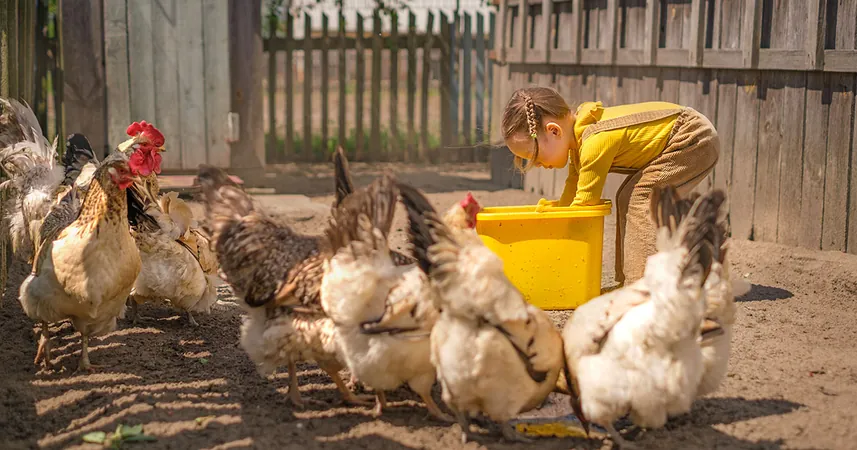
Understanding Bird Flu: Essential Information for Parents Concerned About Their Children’s Safety
2025-01-09
Author: Li
What Is Bird Flu?
Bird flu, or avian influenza, is a viral infection primarily affecting birds. While it predominantly exists among wild aquatic birds, it can also infect domestic poultry like chickens, ducks, and turkeys. The strain that has raised the most concern is the highly pathogenic avian influenza (HPAI), particularly the H5N1, which can have severe health impacts on birds and, albeit rarely, on humans.
How Is Bird Flu Transmitted?
Bird flu viruses, particularly Type A influenza, are naturally occurring in wild waterfowl. These birds often carry the viruses asymptomatically, becoming reservoirs for potential infection. Transmission methods include:
- Direct contact with infected birds or their droppings. - Contaminated surfaces. - Movement of infected poultry. - Migration patterns of wild bird species.
Can Bird Flu Affect Humans?
While it can be transmitted from animals to humans, infections are exceptionally rare and typically occur under conditions involving close contact with infected birds. Common exposure situations include:
- Handling infected poultry. - Visiting live poultry markets during outbreaks. - Living closely with infected backyard poultry.
It’s essential to recognize that human-to-human transmission is uncommon, and being aware of symptoms is crucial.
Symptoms of Bird Flu in Humans
The symptoms of bird flu can mimic those of the regular flu but are often more severe. Parents should be alert for:
- High fever (usually exceeding 100.4°F) - Severe cough - Labored breathing - Muscle pain - Fatigue - Sore throat
If your child has been in contact with birds and starts showing these symptoms, seeking medical advice is paramount.
Safe Food Practices Regarding Poultry
Here’s some comforting news: you can't contract bird flu from properly cooked poultry. To maintain food safety, follow these guidelines when handling poultry products:
- Always wash hands after handling raw chicken. - Keep raw poultry separate from other foods. - Use dedicated cutting boards and utensils for raw bird products. - Cook poultry to an internal temperature of 165°F.
Rest assured, commercial poultry in the U.S. is rigorously monitored, and food safety measures are adhered to throughout production.
Precautions for Pet Bird Owners
The risk of pet birds contracting bird flu is minimal, especially for those kept indoors without contact with wild or domestic birds. Here are some safety tips for bird owners:
- Maintain hygiene by washing hands after handling birds and cleaning their environments. - Observe your pet for signs of illness, such as changes in appetite or behavior.
If you own both indoor birds and backyard poultry, practice strict hygiene, including changing clothes and washing hands between interactions.
What About Other Family Pets?
Though dogs and cats can theoretically contract bird flu, the risk remains extremely low. Recommendations for pet owners include:
- Keep pets indoors, especially during outbreaks. - Prevent them from hunting or consuming wild birds. - Consult a veterinarian if unusual symptoms arise.
Recent Developments: Bird Flu in Cattle
In March 2024, reports emerged of a new strain of bird flu affecting dairy cattle, leading to mild respiratory issues. At least 40 people working with infected cattle have shown mild symptoms, underlining the importance of safety measures on farms. The general public's risk remains low, but it's wise to be cautious, particularly around raw dairy products.
Bird Flu Prevention Tips
To safeguard your family, consider these prevention strategies:
- Educate children to avoid contact with wild birds, particularly those appearing sick or dead. - Practice proper hand hygiene, especially around food. - If considering raising chickens at home, check in with local agricultural offices for advice.
While the chances of contracting bird flu are minimal, staying informed and practicing hygiene is essential for your family’s health amid ongoing outbreaks.

 Brasil (PT)
Brasil (PT)
 Canada (EN)
Canada (EN)
 Chile (ES)
Chile (ES)
 Česko (CS)
Česko (CS)
 대한민국 (KO)
대한민국 (KO)
 España (ES)
España (ES)
 France (FR)
France (FR)
 Hong Kong (EN)
Hong Kong (EN)
 Italia (IT)
Italia (IT)
 日本 (JA)
日本 (JA)
 Magyarország (HU)
Magyarország (HU)
 Norge (NO)
Norge (NO)
 Polska (PL)
Polska (PL)
 Schweiz (DE)
Schweiz (DE)
 Singapore (EN)
Singapore (EN)
 Sverige (SV)
Sverige (SV)
 Suomi (FI)
Suomi (FI)
 Türkiye (TR)
Türkiye (TR)
 الإمارات العربية المتحدة (AR)
الإمارات العربية المتحدة (AR)